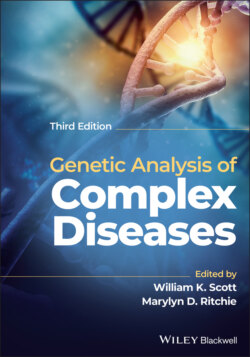Читать книгу Genetic Analysis of Complex Disease - Группа авторов - Страница 38
Genes, Mitosis, and Meiosis
ОглавлениеA cell’s ability to reproduce itself is critical to the survival of an organism. This cell duplication process, utilized by somatic cells, is called mitosis. Similarly, an organism’s ability to reproduce itself is critical to the survival of the species. In sexual organisms, the reproductive process involves the union of gametes (sperm and egg cells), which are haploid. Meiosis is the process by which these haploid gametes are formed from a diploid cell and is the biological basis of linkage analysis.
Meiosis consists of two parts: meiosis I and meiosis II. In meiosis I, which is called the reduction division stage, each chromosome in a cell is replicated to yield two sets of duplicated homologous chromosomes. During meiosis I, physical contact between chromatids may occur, resulting in the formation of chiasmata. Chiasmata are thought to represent the process of crossing over or recombination, in which an exchange of DNA between two (of the four) chromatids occurs (Figure 2.8). A chiasma occurs at least once per chromosome pair; thus, each chromosome pair undergoes at least one recombination event per meiotic division. Despite being physically linked, or syntenic, loci on the same chromosome may segregate independently from each other. When two loci are unlinked to one another, the recombination fraction (θ) between them is 0.50. The upper limit for observed recombination between two unlinked loci is set at 50% because the frequency with which odd numbers of recombination events between a pair of loci occur should equal the frequency with which even numbers of recombination events occur; when an even number of recombination events occurs between two loci, the resultant gametes appear to be nonrecombinant and hence these recombination events are unobserved. However, two loci that are located closely on the same chromosome have a low likelihood of experiencing a recombination event between them and nearly always segregate together. These loci are considered to be genetically linked (Figure 2.9). Linkage analysis (Chapter 6) is a method of determining whether two loci are genetically linked when passed on from one generation to the next through measuring the recombination fraction (θ) between loci.
Figure 2.8 Genetic results of crossing over: (a) no crossover: A and B remain together after meiosis; (b) crossover between A and B results in a recombination (A and B are inherited together on a chromosome, and A and B are inherited together on another chromosome); (c) double crossover between A and B results in no recombination of alleles.
(Source: Reprinted by permission from Jorde et al. (1995).)
Following recombination, at least two of the four chromatids become unique, unlike those of the parent. The cellular division process that occurs ensures that one paternal homologue and one maternal homologue are transmitted to each of two diploid daughter cells. This cell division marks the end of meiosis I. The process of genetic recombination helps to preserve genetic variability within a species by allowing for virtually limitless combinations of alleles in the transmission from parent to offspring. Estimates of genetic recombination can also predict distance between two loci: The closer two loci are to one another, the less chance for recombination between them. The frequency of recombination is not uniform through the genome. Some areas of some chromosomes have increased rates of recombination (hot spots), while others have reduced rates of recombination (cold spots). For instance, recombination frequencies may vary between sexes or may vary depending on whether the loci are at the telomere or centromere of the chromosome.
The second phase of meiosis is identical to a mitotic (somatic cell) division, in which genetic material is transmitted equally, identically, and without recombination to daughter cells. However, in contrast to a mitotic division, which yields two identical diploid daughter cells, the end result of the entire meiotic process in sperm cells is four haploid daughter cells with chromosomal haplotypes different from those originally present in the parent; in egg cells, the final outcome is a single haploid daughter cell, with the remainder of the genetic material lost because of the formation of nonviable polar bodies.
The fundamental differences between meiosis and mitosis are summarized in Table 2.2.
Figure 2.9 Genes that are on the same chromosome (syntenic) may be unlinked or linked. Loci A/a and B/b are syntenic and linked because their physical distance is short enough that recombination is less likely to occur between them, resulting in a lower recombinant to nonrecombinant gamete ratio. Loci R/r and G/g are syntenic and unlinked because their physical distance is great enough that a recombination event will occur between them during meiosis resulting in equal proportions of recombinant and nonrecombinant gametes.
Table 2.2 Differences between meiosis and mitosis.
| Meiosis | Mitosis | |
|---|---|---|
| Purpose | Produce gametes; ensure or produce genetic variability through recombination | Replace somatic cells |
| Location | Gonads | Body cells |
| Number of cell divisions per cycle | Two: meiosis I and meiosis II (latter identical to mitosis) | One |
| Chromosome number in daughter cells | Halved from parental complement to produce gametes; resultant cells are haploid | Identical to parental complement; resultant cells are diploid |
| Recombination | Occurs in diplotene of prophase I of meiosis I | Occurs rarely, usually result of abnormality |
